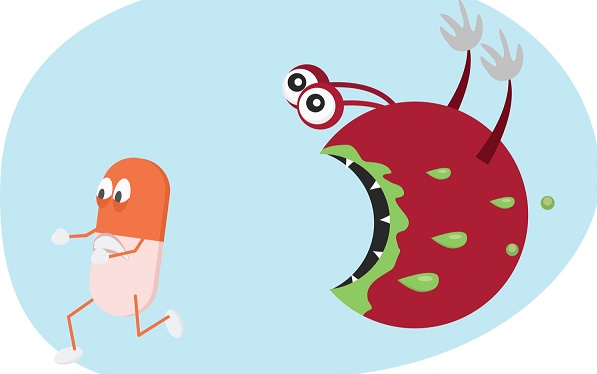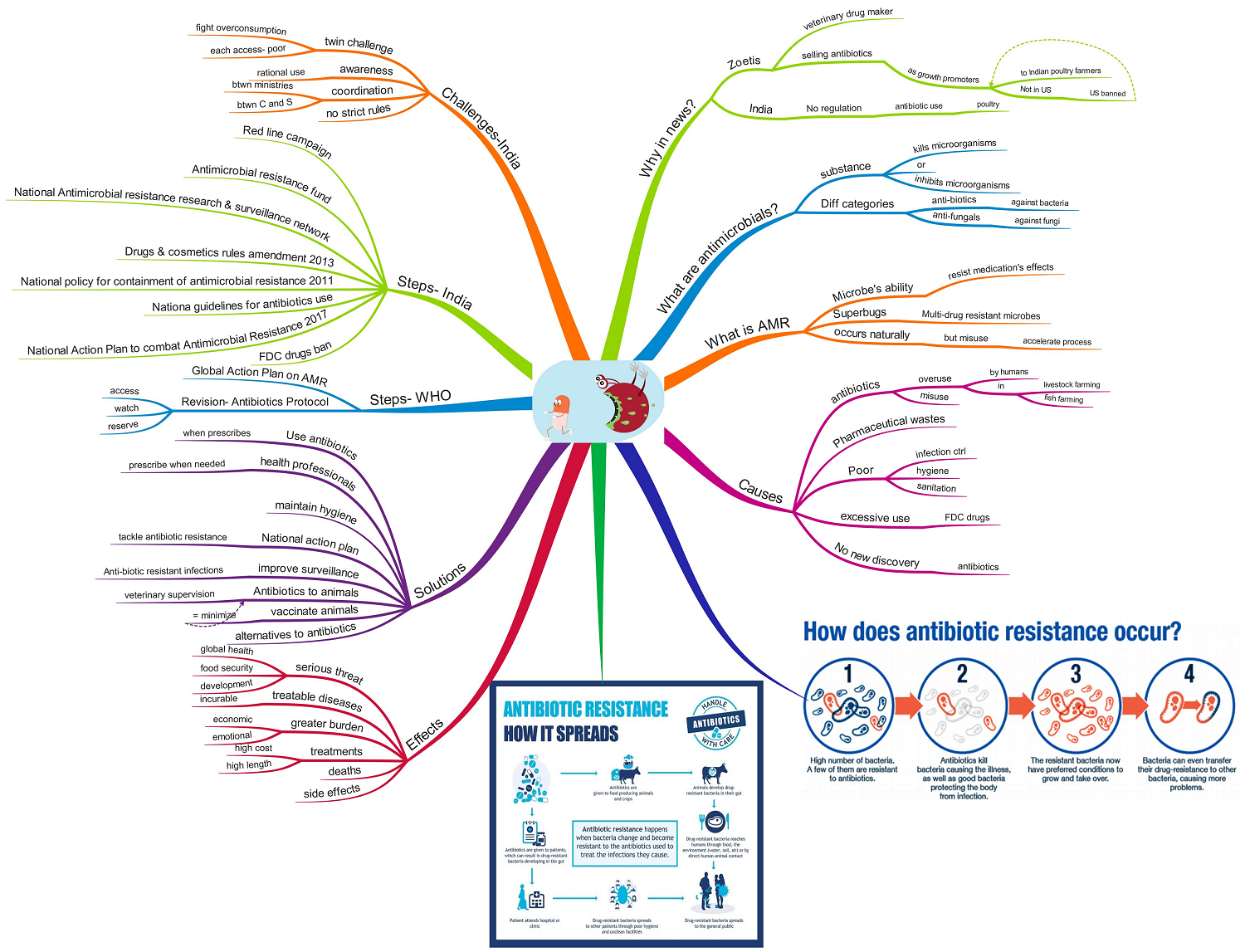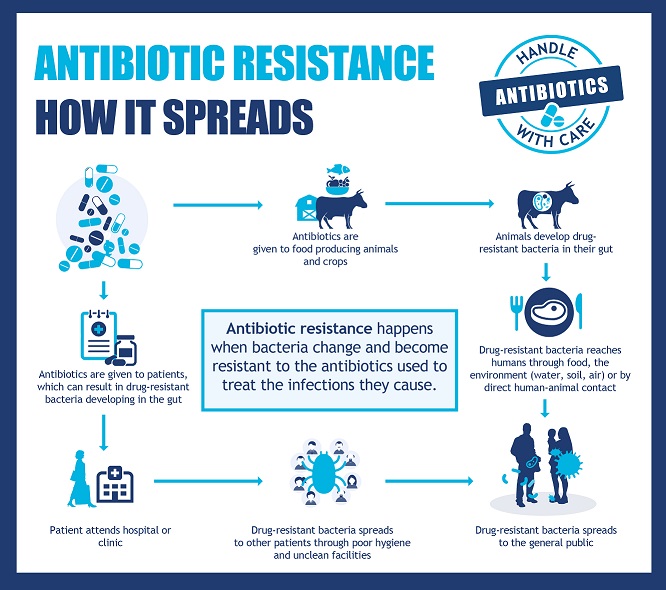Antimicrobial Resistance – A Global Threat to Public Health

* Updates (not available in mindmap)
There are a number of diseases that occur due to microbes (microorganisms) like bacteria, viruses, and parasites. Antibiotics fight against these microbes and they are widely used in the treatment and for preventing infections. However, the problem arises when people consume these antibiotics frequently. This creates antibiotic resistance where the drug does not benefit human health, but of the microbes as they are used to the drug.
By the year 2050, antimicrobial resistance (AMR) is estimated to account for around 10 million deaths each year around the world, of which 2 million are expected to occur in India alone. Around 30% of neonatal sepsis deaths in India are associated with AMR. Therefore India, a pharma super-power, should fix this grave threat of antimicrobial resistance.*
What are antimicrobials?
- An antimicrobial is a substance that kills microorganisms or inhibits their growth
- Antimicrobial medicines can be categorized based on the microorganisms they mainly act against.
- For example, Antibiotics are used against bacteria, and Antifungals are used against fungi.
What is Antimicrobial resistance (AMR)?
- Antimicrobial resistance is the ability of a microbe to resist the effects of medication or anti-microbial previously used to fight them. Thus the infections persist in the body, increasing the risk of spread to others.
- Resistant microbes are more difficult to treat, necessitates alternative mechanisms or higher doses, both of which are either expensive or more toxic.
- Microbes that are resistant to multiple antimicrobials are called multidrug-resistant (MDR) or sometimes superbugs.
- Antimicrobial resistance occurs naturally, but the misuse of antibiotics in humans and animals is accelerating the process.
What are the causes of AMR?
- Antimicrobial resistance occurs naturally but is gradual or slow. But the following factors accelerate the process.
- Overuse of antibiotics by consuming more antibiotic than prescribed.
- Misuse by taking a prescribed antibiotic incorrectly or taking antibiotics to treat viral infection. Patients generally not complete the entire antibiotic course.
- Overuse of antibiotics in livestock and fish farming. Consumption of antibiotically treated livestock such as chicken further increases resistance.
- Antibiotics discharge or waste from pharma firms and hospitals. For instance, Hyderabad’s pharmaceutical industry has been pumping massive amounts of antibiotics into local lakes, rivers, and sewers. This has led to an explosion in resistance genes in these waterbodies.
- Poor infection control in healthcare settings.
- Poor hygiene and sanitation.
- Excessive use of Fixed Dose Combinations (FDC) Drugs due to its low price and convenience enabling anti-biotic resistance to grow at a significant rate.
- The absence of new antibiotics being discovered.
How does AMR occur?
How AMR spreads?
What are the effects of AMR?
- AMR poses a serious threat to global health, food security, and development.
- The danger of antimicrobial resistance is those treatable illnesses like pneumonia, tuberculosis or minor infections could become incurable. This would put a greater economic and emotional burden on families and on our healthcare system.
- Increased cost and length of treatments and increased deaths.
- Increased side effects from the use of multiple and more powerful medications.
How to deal with it?
- Individuals to use antibiotics only when prescribed
- Health professionals to prescribe antibiotics only when they are needed
- Preventing infections by maintaining hygiene
- A robust national action plan to tackle antibiotic resistance
- Improve surveillance of antibiotic-resistant infections
- Only give antibiotics to animals under veterinary supervision
- Vaccinate animals to minimize the need for antibiotics
- Use alternatives to antibiotics when available
Antimicrobial Resistance in India:
- India is the country that stands to lose most from antibiotic resistance considering the burden of infectious diseases in the country that is among the highest in the world. If these miracle drugs stop working, no one will be hit harder than India.
- According to the World Health Organisation (WHO), antibiotic resistance may cause an increase in death of Indians to 20 lakhs per year by 2050.
- India faces rising instances of diseases such as tuberculosis which is becoming resistant to frontline drugs.
- Scientists have recently isolated resistant causing MCR (Mobilised Colistin Resistance)-1 gene in a strain of E.coli in India. MCR-1 gene is responsible for resistance against the antibiotic colistin which is considered to be the last mile antibiotic that the human race has currently access to. This is alarming news and could make India’s fight against AMR all the more difficult.
What are the steps taken by the World Health Organisation (WHO)?
Global action plan on antimicrobial resistance (5 strategic objectives)
- To improve awareness and understanding of antimicrobial resistance
- To strengthen surveillance and research.
- To reduce the incidence of infection.
- To optimize the use of antimicrobial medicines.
- To ensure sustainable investment in countering antimicrobial resistance.
Revision of antibiotics protocol
WHO has revised antibiotics protocol to curb antibiotic resistance. This is the biggest revision of the antibiotics section in the essential medicines list (EML) which is being used by countries to develop their own local lists of essential medicine.
Under this, WHO has divided the drugs into 3 categories viz – access, watch and reserve.
- The access category includes commonly used antibiotics. They will be available at all times as the treatment for a broad range of common infections.
- The watch category covers antibiotics that are recommended as a first or second choice treatment for a small group of infections. Prescription of these drugs should be minimized to avoid further development of resistance.
- The reserve category includes antibiotics that are considered last-resort options and should be used only in the most severe circumstances like life-threatening infections caused by multi-drug resistant (MDR) bacteria.
What are the steps taken by India?
Red Line Campaign
- It was launched in 2016
- Under this, Prescription only antibiotics were marked with a red line to curb the irrational use
- The government has also backed it up with a communication campaign in order to create awareness that red line medicines should not be taken without the prescription.
Anti-Microbial Resistance Fund
- India-focused seed fund
- Investment by Department of Biotechnology (DBT) through the Biotechnology Industry Research Assistance Council (BIRAC)
- It will help groups in India compete for the Longitude prize (for groups that develop effective and affordable diagnostic kit to detect antimicrobial resistance).
National Anti-Microbial Resistance Research and Surveillance Network (AMRRSN)
- Established by Indian Council of Medical Research (ICMR)
- To strengthen surveillance of AMR in the country
- To enable compilation of national data of AMR at various levels of health care.
2013 Amendment of the Drugs and Cosmetic Rule, 1945
- To include a new schedule H1
- H1 drugs will be sold only on prescription
- They are also marked with Red Line (Red Line Campaign)
National Policy for Containment of Antimicrobial Resistance, 2011
National Guidelines for the use of Antibiotics
National Action Plan to Combat Antimicrobial Resistance, 2017
- Enhancing awareness among masses and strict adulteration laws
- Strengthening surveillance
- Improving the rational use of antibiotics
- Reducing infections
- Promoting policies and research in antimicrobial resistance
- Support neighbouring nations in the fight against infectious diseases
AMR Research & International Collaboration: *
- ICMR has taken measures to develop new drugs /medicines by means of international collaborations for strengthening medical research in AMR.
Initiatives to control overuse or misuse of antibiotics: *
- ICMR has launched antibiotic stewardship program (AMSP) on a pilot project basis in twenty tertiary care hospitals across India to check the misuse and overuse of antibiotics in hospital wards and ICUs.
- On the advice of ICMR, DCGI has prohibited 40 fixed-dose combinations (FDCs) which were found inapplicable.
- ICMR collaborated with the Indian Council of Agriculture Research, Department of Animal Husbandry, Dairy and Fisheries and the DCGI to prohibit the use of Colistin as a growth promoter in animal feed in poultry.
What are the challenges for India in its fight against Antimicrobial Resistance?
- India faces a twin challenge of fighting overconsumption of antibiotics while ensuring that the poor and vulnerable have easy access.
- Lack of awareness among medical practitioners as well as the general public on the rational use of antibiotics further aggravates the problem.
- Coordination among various ministries and between the centre and state governments.
- The rules and regulations that were taken were not strict enough to prevent pharmaceutical firms to sell last-resort drugs to farmers or discharge waste into water bodies.
What is the way forward?
- The success of the government’s actions against AMR would depend on the implementation of national-level programmes,
- To support small-scale animal farms,
- To manage waste from animal farms, animal food processing, and pharmaceutical manufacturing sector and healthcare facilities.
- The sale of antibiotics should not be considered as a business by governments, private companies, and individuals who have the power to stall post-antibiotic health complications.
- That is why India’s progress towards a stricter regulatory regime must pick up the pace. As India takes its time to create regulations, the toll from antibiotic misuse is growing at an alarming rate.
- According to a 2013 study, around 58,000 new-borns die in India every year due to sepsis from resistant bacteria. When these numbers mount, India will have no one to blame but itself.
Practice Question
Antimicrobial resistance is one of the biggest health concerns of the 21st century. Discuss the reasons.
If you like this post, please share your feedback in the comments section below so that we will upload more posts like this.




